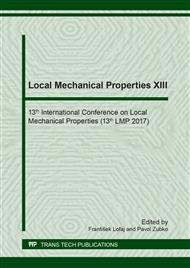[1]
E. Bruhwiler, F.H. Wittmann, The wedge splitting test: a new method of performing fracture mechanics tests, Engineering Fracture Mechanics, 35, (1990), 117–125.
DOI: 10.1016/0013-7944(90)90189-n
Google Scholar
[2]
I. Merta, E.K. Tschegg, fracture energy of natural fibre reinforced concrete, Construction and Building Materials, 40, (2013), 991–997.
DOI: 10.1016/j.conbuildmat.2012.11.060
Google Scholar
[3]
R. Walter, L. Østergaard, J.F. Olesen, H. Stang, Wedge splitting test for a steel-concrete interface, Engineering Fracture Mechanics, 72, (2005), 2565–2583.
DOI: 10.1016/j.engfracmech.2005.06.001
Google Scholar
[4]
S. Seitl, B. Nieto García, I. Merta, Wedge splitting test method: quantification of influence of glued marble plates by two-parameter fracture mechanics, Frattura ed Integtita Strutturale, 30, (2014), 174–181.
DOI: 10.3221/igf-esis.30.23
Google Scholar
[5]
ASTM E 1221-96, Standard Method for Determining Plane-Strain Crack-Arrest Toughness, KIa, of Ferritic Steels, American Society for Testing and Materials, Philadelphia, PA, (2002).
DOI: 10.1520/e1221-12ar18
Google Scholar
[6]
S. Seitl, P. Hutař, Z. Knésl, Sensitivity of fatigue crack growth data to specimen geometry, Key Engineering Materials, 385-387, (2008), 557–560.
DOI: 10.4028/www.scientific.net/kem.385-387.557
Google Scholar
[7]
H.N. Linsbauer, E.K. Tschegg, Fracture energy determination of concrete with cube-shaped specimens, Zement und Beton, 31 (1986), 38–40.
Google Scholar
[8]
E.K. Tschegg, Republic Österreich. Patent number 390328B, (1986).
Google Scholar
[9]
G.V. Guinea, M. Elices, J. Planas, Stress intensity factors for wedge-splitting geometry, International Journal of Fracture, 81, (1996), 113–124.
DOI: 10.1007/bf00033177
Google Scholar
[10]
S. Seitl, I. Merta, V. Veselý, Wedge splitting test of foam concrete specimens: Calibration curves, Key Engineering Materials, 627, (2015), 281–284.
DOI: 10.4028/www.scientific.net/kem.627.281
Google Scholar
[11]
V. Veselý, L. Řoutil, S. Seitl, Wedge-splitting test - Determination of minimal starting notch length for various cement based composites part I: Cohesive crack modelling, Key Engineering Materials, 452–453, (2011), 77–80.
DOI: 10.4028/www.scientific.net/kem.452-453.77
Google Scholar
[12]
V. Veselý, P. Frantík, J. Sobek, L. Malíková, S. Seitl, Multi-parameter crack tip stress description for evaluation of nonlinear zone width in silicate composite specimens in component splitting/bending test geometry, Fatigue and Fracture of Engineering Materials and Structures, 38(2), (2015).
DOI: 10.1111/ffe.12170
Google Scholar
[13]
V. Veselý, J. Sobek, L. Šestáková, P. Frantík, S. Seitl, Multi-parameter crack tip stress state description for estimation of fracture process zone extent in silicate composite WST specimens, Frattura ed Integrita Strutturale, 7(25), (2013).
DOI: 10.3221/igf-esis.25.11
Google Scholar
[14]
D. Li, L. N. Y., Wong, The Brazilian disc test for rock mechanics applications: review and new insights. Rock mechanics and rock engineering, 46 (2), (2013), 269–287.
DOI: 10.1007/s00603-012-0257-7
Google Scholar
[15]
S. Seitl, P. Miarka, Evaluation of mixed mode I/II fracture toughness of C 50/60 from Brazilian disc test, Frattura ed Integrita Strutturale, 42, (2017), 119–127.
DOI: 10.3221/igf-esis.42.13
Google Scholar
[16]
E.K. Tschegg, A. Schneemayer, I. Merta, K. Rieder, Energy dissipation capacity of fibre reinforce concrete under biaxial tension-compression load. Part I: Test equipment and work of fracture, Cement & Concrete Composite, 62, (2015), 195–203.
DOI: 10.1016/j.cemconcomp.2015.07.002
Google Scholar
[17]
E.K. Tschegg, A. Schneemayer, I. Merta, K. Rieder, Energy dissipation capacity of fibre reinforced concrete under biaxial tension-compression load. Part II: Determination of the fracture process zone with the acoustic emission technique, Cement & Concrete Composite, 62, (2015).
DOI: 10.1016/j.cemconcomp.2015.07.003
Google Scholar
[18]
M.L. Williams, On the stress distribution at the base of a stationary crack, Journal of Applied Mechanics, 24 (1975), 109–114.
Google Scholar
[19]
S. Seitl, V. Veselý, L. Řoutil, Two-parameter fracture mechanical analysis of a near-crack-tip stress field in wedge splitting test specimens, Computers and Structures, 89, (2011), 1852–1858.
DOI: 10.1016/j.compstruc.2011.05.020
Google Scholar
[20]
A. Schneemayer, Uniaxiales und biaxiales Bruchverhalten von Faserbeton, Diplomarbeit, TUW (2010).
Google Scholar


